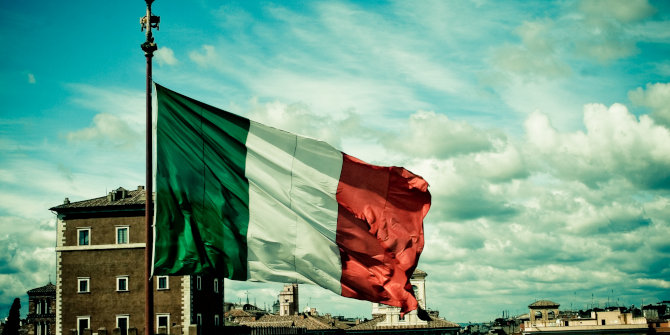Much has been written about the rise of the ‘Alt-Right’ and its role in American and European politics. However, the use of the term ‘Alt-Left’ remains far more contested. Steve Fuller writes that while the term is often used in a pejorative sense, there is the potential for left-wing actors to reclaim the Alt-Left label as part of a wider reorientation of the politics of the left.
The ultimate take-home message of the post-truth condition is that s/he who controls the frame controls the game. What is most striking about the rise of the Alt-Right is that it began as a newsfeed, Breitbart. A newsfeed provides the ideal platform from which to frame people’s understanding of themselves and their world. As part of the normal curatorial function of newsfeeds, judicious editing can easily and imperceptibly morph into deliberate spin.
In the past, this would have been called ‘propaganda’, but propaganda operated by rigidly defined norms that typically targeted quite specific beliefs, which were then relentlessly promoted and/or opposed. In the case of a newsfeed, most of the news content is already given by press agencies that canvas stories from across the world, and the newsfeed simply decides whether to run them and, if so, how to make them more attractive for its readers. Nudging is the name of this game, and much of what passes for ‘fake news’ results from this process.
No comparable newsfeed currently exists for what might be called the ‘Alt-Left’, the proper ideological opponent of the ‘Alt-Right’. Nevertheless, it is a testimony to Breitbart’s diabolical genius that it has tried to pre-empt the formation of a proper ‘Alt-Left’ by using it as an epithet for self-styled ‘Antifa’ (i.e. anti-fascist) members who violently clashed with Alt-Right protesters last summer over the removal of monuments to major Confederate military figures in the US Civil War who had defended the right to hold slaves.
The ‘diabolical genius’ of this labelling lay in casting the Alt-Left as viscerally against the unqualified exercise of free speech that has been the Alt-Right’s calling card to enter polite liberal society. It had been the pretext for the Alt-Right protests on behalf of the fallen Confederate generals. And if the distinction is defined on those terms, then clearly the Alt-Right appears more attractive than the Alt-Left, since the Alt-Left would amount to nothing more than an anti-Alt-Right.
The Alt-Right spin on ‘Alt-Left’ is not so easy to shake because of the rise of ‘speech codes’ and ‘no platforming’ on university campuses, all done in the name of the classical left-wing cause of ‘social justice’. Yet at the same time these actions are widely interpreted – including by many self-avowed liberals – as censoring free expression, which in turn serves to reinforce the Alt-Right’s image of what an ‘Alt-Left’ might be.
To counter that dialectical trajectory, those wanting a proper Alt-Left should take a page from the Alt-Right’s own playbook and delve deep into the Left’s own psyche to redraw its ideological ground – in particular, to rediscover its own positive understanding of freedom.
Marxism’s terminal decline as an emancipatory project – starting with the Frankfurt School and culminating with the fall of the Soviet Union – has corresponded to the left’s increasingly negative attitude towards freedom as something that can or perhaps even should be achieved. Indeed, ‘freedom’ rarely occurs without scare quotes around words and deeds that need to be ‘critiqued’ and ‘resisted’, respectively, whenever they come from representatives of the established order.
Any genuine Alt-Left needs to shake off this heritage, which is the academically curdled remnant of the Left’s disappointed hopes in the wake of the 1917 Bolshevik Revolution. Andrew Breitbart may not have been a great intellectual historian, but he understood this point perfectly – and even blamed the Frankfurt School for the left’s deep scepticism about the very idea of freedom.
Moreover, Breitbart even stole some of the thunder from the Frankfurt School’s sense of disappointment for the Alt-Right, as expressed in the Alt-Right’s unremitting suspicion of the state as a liberating agent, even in its most seemingly ‘liberal’ guises. Thus, we live in times when ‘classical liberals’ flirt with if not outright support Alt-Right icon Donald Trump who treats his current residency in Washington as a ‘swamp’ that needs to be ‘drained’.
Towards an Alt-Left that it can call its own
Those concerned with the future of the left need to understand its history properly. Two wedges have been driven into the coalition of people who we now call ‘liberals’ and ‘socialists’ that opposed the ancient regime in the French Revolution and hence sat on the left side of the National Assembly.
The first divide occurred after the failed 1848 European revolutions, which resulted in The Communist Manifesto as the most influential expression of socialist disenchantment with liberal meliorism. However, that still left the door open for liberals to migrate to socialism. The result was ‘social democracy’, in terms of which John Stuart Mill functions as a Moses figure. Its greatest political achievement was the welfare state.
However, the second divide – corresponding to the Russian Revolution – effectively stopped that flow of liberals to socialism. Radical disenchantment with Soviet policies led liberals to pull back from socialism in various ways, ranging from the critical disengagement of the Frankfurt School to the market fundamentalism of the Mont Pèlerin Society, which spawned today’s ‘neo-liberalism’.
What got lost along the way was the original Enlightenment idea that purposive collective action might increase the sphere of individual freedom. And here we need to imagine ‘market’ and ‘state’ equally as collective agents, differing only in terms of mode of purposiveness.
As Emma Rothschild has made clear, in the eighteenth century the two sorts of collective agents were seen as mutually implicated, not simply traded off against each other, as in today’s sense of ‘market failure’.
The state was originally seen as the agency by which markets would be brought into existence – to break the hold that hereditary entitlement and royal patronage had over the ability of people to explore their full capacities. Today’s ‘neo-liberalism’ is clearly a latter-day descendant of this sensibility, however much self-described ‘leftists’ wish to deny it.
The original ‘leftist’ premise that joined liberals and socialists in common cause was that people can be much more than they are, if they are not held back by repressive social structures that circumscribe their opportunities, sometimes from birth. Moreover, these social structures do not exist as free-floating natural laws but are in symbiosis with existing modes of authority, both political and religious, that provide legitimacy for these arrangements. These have often been expressed as historically based ‘entitlements’.
While ‘smart’ academic opinion still tends to follow Alexis de Tocqueville’s view that ‘liberty’ and ‘equality’ in the original French Revolution slogan necessarily trade off against each other, a genuine Alt-Left would rediscover why they were placed on the same side in the first place. The relevant sense of equality was what we now call ‘equality of opportunity’, which presupposes that in some sense history could be erased to enable each generation to start at the same level to demonstrate their true worth.
Given the history of thwarted human potential, liberals and socialists agreed that only a ‘revolution’ in the sense of a re-booting of society – or, in Enlightenment terms, a re-drafting of the social contract – could bring about the requisite changes. Where liberals and socialists differed was over the sort of violence – by whom, to whom and of what sort – required. This also should be the point to which a self-avowed Alt-Left should itself re-boot.
But what would that entail in terms of politically reorienting today’s left? I can only take a first step here. It would involve reviving the original left’s strong distinction between humanity’s past, as embodied in its history, and humanity’s future, as embodied in its potential – the one to be discarded, or at least avoided, and the other to be cultivated and made allowed to flourish. This would mean restoring ‘progress’ as a central term in political discourse and steering away from more past-looking ‘reparative’ notions of social justice, which have made it all too easy for Breitbart to concoct its own, currently dominant version of an ‘Alt-Left’.
Steve Fuller is the author of Post-Truth: Knowledge as a Power Game, which will be released in spring 2018
Please read our comments policy before commenting.
Note: This article gives the views of the author, not the position of EUROPP – European Politics and Policy or the London School of Economics.
_________________________________
 Steve Fuller – University of Warwick
Steve Fuller – University of Warwick
Steve Fuller holds the Auguste Comte Chair in Social Epistemology in the Department of Sociology at the University of Warwick.





so in a long version, no you cant tell me what alt left is. that may be because you are extremely left yourself
I agree. Only an extremist could think extremism can’t exist. To them extreme is normal. Hence the article.
Very much agree with the comments. The alt-left promotes the exact same hatred the alt-right spews but disguises it as “progressive.” Like someone else said, it disguises itself as “normal.” I’ve only just begun to realize how my childhood was shaped by extremism without even realizing it. Now as an adult who has ran away from politics completely, I watch my friends who are still in those spaces fall for it. I only stopped thinking in black and white because of personal trauma, to unravel theirs with words would simply be impossible.